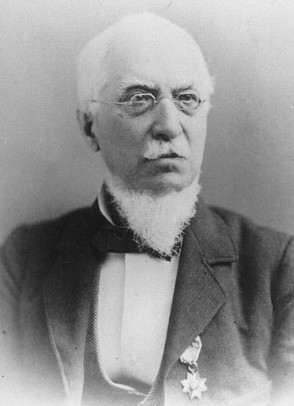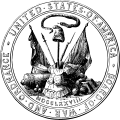
The territory of the United States and its overseas possessions has evolved over time, from the colonial era to the present day. It includes formally organized territories, proposed and failed states, unrecognized breakaway states, international and interstate purchases, cessions, and land grants, and historical military departments and administrative districts. The last section lists informal regions from American vernacular geography known by popular nicknames and linked by geographical, cultural, or economic similarities, some of which are still in use today.

California's involvement in the American Civil War included sending gold east to support the war effort, recruiting volunteer combat units to replace regular U.S. Army units sent east, in the area west of the Rocky Mountains, maintaining and building numerous camps and fortifications, suppressing secessionist activity and securing the New Mexico Territory against the Confederacy. The State of California did not send its units east, but many citizens traveled east and joined the Union Army there, some of whom became famous.
The Pacific coast theater of the American Civil War consists of major military operations in the United States on the Pacific Ocean and in the states and Territories west of the Continental Divide. The theater was encompassed by the Department of the Pacific that included the states of California, Oregon, and Nevada, the territories of Washington, Utah, and later Idaho.

The 4th California Infantry was a volunteer infantry regiment recruited from northern California during the American Civil War. It was organized at Sacramento, Placerville, and Auburn in September and October 1861.

George Wright was an American soldier who served in the Mexican–American War and the American Civil War.

The 3rd Regiment California Volunteer Infantry was an infantry regiment in the Union Army during the American Civil War. This regiment was organized at Stockton and at Benicia Barracks, from October 31 to December 31, 1861, to serve three years. The regiment was first commanded by Colonel Patrick Edward Connor. After the formation of the regiment at Stockton, four companies were sent to Humboldt County during the month of November, 1861. During the month of July, 1862, Colonel Connor was sent, with his regiment, to the District of Utah, in which it was on duty for the balance of its term of service.

The District of Oregon was a Union Army command department formed during the American Civil War.

The 2nd Regiment California Volunteer Infantry was an infantry regiment in the Union Army during the American Civil War. It spent its entire term of service in the western United States. Organized at San Francisco and Carson City September 2, 1861, to December 30, 1862, and attached to Department of the Pacific. The regiment was first assembled at the Presidio, San Francisco, and after completing its organization, five companies were sent to Oregon and Washington Territory, to relieve the regular troops, and two companies were sent to Santa Barbara. The troops of this regiment sent to Oregon were afterwards returned to California. It was mustered out during the month of October, 1864.
During the American Civil War in the early 1860s, the District of Utah was a subordinate district of the U.S. Army's Department of the Pacific. The district was composed of territorial areas that later became parts of the modern U.S. states of Idaho, Nevada, and Utah.
The Department of New Mexico was a department of the United States Army during the mid-19th century. It was created as the 9th Department, a geographical department, in 1848 following the successful conclusion of the Mexican–American War, and renamed Department of New Mexico in 1853. It had to contend with an invading Confederate force during the New Mexico Campaign of the American Civil War from mid-1861 to early 1862, then with Apache tribes during the remainder of the conflict. It was merged into the Department of California after the end of the war as the District of New Mexico.
The District of California was a Union Army command department formed during the American Civil War. The district was part of the Department of the Pacific, the commander of the department also being District commander. The district was created as a separate command on July 1, 1864, after Irvin McDowell took command of the Department of the Pacific, relieving General Wright, who then remained as District of California commander. The District comprised the state of California and the areas of the Rogue River and Umpqua River in Southern Oregon. Its headquarters were in San Francisco, co-located with those of the Department of the Pacific. On March 14, 1865, the District of Oregon was extended to include the entire state of Oregon, removing the Rogue River and Umpqua River areas from the District.
The 6th Regiment California Volunteer Infantry was an infantry regiment in the Union Army during the American Civil War. It spent its entire term of service in the western United States attached to the Department of the Pacific. The Regiment was organized at Benicia Barracks, San Francisco on February 1, 1863. 6th Regiment mustered out from October 25 to December 20, 1865. The only recorded engagements of the Regiment occurred with the detachment sent to the Humboldt Military District in 1864, near the end of the Bald Hills War. It had engagements with the Indians in the Skirmish at Booth's Run, May 1 and Kneeland's Prairie May 2, near Boynton's Prairie May 6 and at Grouse Creek May 23.

The 8th Regiment California Volunteer Infantry was an infantry regiment in the Union Army during the American Civil War. Raised in the last year of the war, it spent its entire term of service serving in posts around San Francisco Bay, and on the Columbia River, attached to the Department of the Pacific, before mustering out in late 1865.

The Department of Oregon was one of two Army Departments created September 13, 1858, replacing the original Department of the Pacific and was composed of the Territories of Washington and Oregon, except the Rogue River and Umpqua Districts, which were assigned to the Department of California. Its creation was authorized by General Orders, No. 10, of the United States Department of War, Adjutant-General's Office, September 13, 1858. Its headquarters was at Fort Vancouver, in the Washington Territory.

The Department of California was an administrative department of the United States Army. The Department was created in 1858, replacing the original Department of the Pacific, and it was ended by the reorganizations of the Henry L. Stimson Plan implemented in February 1913. As with the preceding organization, headquarters were in San Francisco. Its creation was authorized by General Orders, No. 10, of the War Department, Adjutant-General's Office, September 13, 1858.
Pacific Division of the U. S. Army was one of its superior administrative organizations that existed during the early 19th century and for a short time in the early 20th century.

Albemarle Cady was a career United States Army officer who served in the Second Seminole War, Mexican–American War, First Sioux War and the American Civil War. During the Civil War, he was briefly lieutenant colonel of the 7th Infantry Regiment. He then served in administrative positions in the Department of the Pacific, including the District of Oregon. He received brevet appointments for his service in the Mexican–American War and the Civil War. He retired from the Regular Army as a colonel on May 18, 1864. On July 17, 1866, President Andrew Johnson nominated and on July 26, 1866, the United States Senate confirmed the appointment of Cady as a brevet brigadier general in the Regular Army, to rank from March 13, 1865.

Marcus Peter Miller was a career officer in the United States Army. A Union Army veteran of the American Civil War and a U.S. Army veteran of the American Indian Wars, Spanish–American War, Philippine–American War, he served from 1858 to 1899, attained the rank of brigadier general, and was commended for gallantry during several Civil War battles, the Modoc War, Nez Perce War, and the Iloilo campaign of the Philippine–American War.

Charles G. Sawtelle was a career officer in the United States Army. A veteran of the American Indian Wars and American Civil War, he served from 1854 to 1897 and attained the rank of brigadier general while serving as Quartermaster General of the United States Army.











